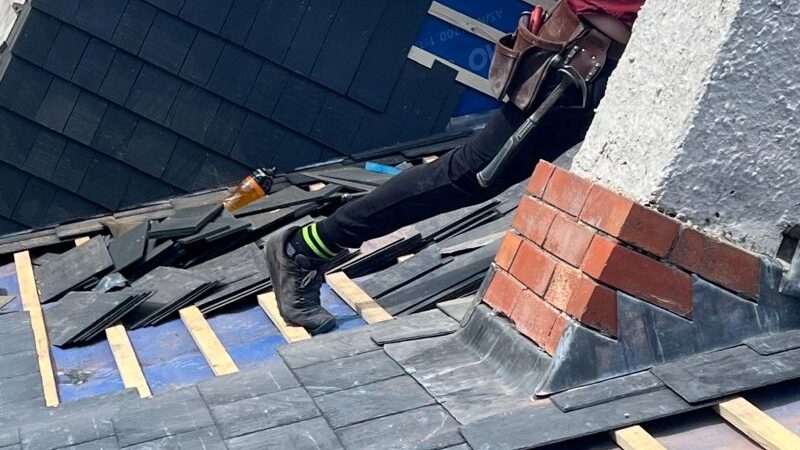Enhance Your Slate Roof’s Longevity and Prevent Costly Leaks with Quality Flashing
Flashing serves as a critical protective barrier at the most exposed points of your roof, particularly where tiles intersect with walls, chimneys, or valleys. Without proper installation of flashing, even the finest slate roof can succumb to leaks, leading to expensive repairs and extensive damage. Lead is the preferred material for flashing in slate roofing due to its remarkable flexibility, extraordinary durability, and ability to accommodate the natural movements of the roof structure, ensuring a tight seal that effectively blocks water ingress.

What Is Flashing and Why Is It Crucial for the Integrity of Your Slate Roof?
Flashing is the essential material used to seal joints and edges around structures such as chimneys, skylights, roof valleys, and any area where your slate roof meets a wall or changes direction. These joints are particularly vulnerable to water infiltration. Without effective flashing, these areas are likely to be the first points of failure, resulting in leaks. In contemporary construction, flashing may be produced from various sheet metals; however, for traditional applications on slate roofs, lead remains the superior material choice.
Why is lead the top choice? This material not only seals effectively but also molds itself to create a robust barrier against various curves and edges. It naturally expands and contracts with temperature fluctuations without the risk of cracking or splitting. Unlike synthetic alternatives, lead does not rust and retains its structural integrity for an extended period, often outlasting the slate itself.
What Are the Consequences If Flashing Fails to Function Correctly?
Even a minor tear or gap in your flashing can lead to severe leaks. These leaks often do not present themselves immediately; water can infiltrate beneath the tiles, reach the underlay, and gradually cause issues such as rot, mold, or damage to your internal ceilings. The consequences of flashing failure may take years to become visible, and by that time, repairs can be extensive and costly. Problems related to flashing are among the leading causes of hidden roof failures.
If you observe stains on your ceiling, bubbling paint near a chimney, or patches of moss accumulating on specific areas of your roof, the deteriorating flashing could be the underlying issue.
Why Is Lead the Optimal Material Choice for Flashing on Slate Roofs?
For centuries, lead has been the go-to material for slate roofs, thanks to its unique attributes. It is recyclable, extremely durable, and can withstand harsh weather conditions, whether exposed to high heat or severe storms. The softness of lead allows it to fit tightly without risking damage to the delicate slate, which is relatively fragile compared to lead.
Common applications for lead flashing include:
- Chimney flashings (both step and apron)
- Roof valleys
- Secret gutters
- Roof-to-wall junctions
- Ridge and hip intersections
- Skylight surrounds
These areas experience constant movement, pressure, and water runoff, making them particularly susceptible to failure when rigid, inflexible materials that can crack or dislodge are used.
When Is It Time to Consider Replacing or Repairing Your Lead Flashing?
While lead flashing is known for its long lifespan, it will inevitably deteriorate over time. You should consider replacement if:
- The lead has developed splits or cracks
- It is lifting or curling away from the roofline
- Rust is evident, especially where lead meets other metals
- Water stains are visible inside your home
- You are already planning a slate roof repair or rebuild
Most slate roof restorations necessitate a thorough inspection of all leadwork. If we are already on your roof for tile replacement or cleaning, that is the most advantageous time to evaluate and replace flashing as needed.
Why Trust Only Skilled Craftspeople for Leadwork Installation and Repair?
Leadwork is a specialized trade that should not be entrusted to just any general roofer or handyman. Improperly installed lead can sag, split, or detach from the slate, negating the benefits of a well-constructed slate roof. Our team utilizes traditional methods for installing lead flashing, ensuring proper sizing, correct lap joints, and expansion joints that accommodate the weather fluctuations typical in Sydney. We are committed to using lead only where it is the most suitable material for the job.
How Can Quality Flashing Reduce Future Roofing Problems?
A slate roof can last for a century or more, but only if its most vulnerable points are effectively protected. Flashing and leadwork may not be the most glamorous components of a roof, yet they are essential elements that bear the burden when weather conditions become severe. If you notice leaks, streaks, or signs of wear around your chimney or roof edges, it is critical to have it evaluated promptly. Replacing flashing now can save you from incurring significantly higher repair costs for structural damage later.
Do You Need a Professional Inspection for Your Leadwork?
If your slate roof features flashing that has seen better days or shows signs of deterioration, it is prudent to have it examined before minor issues escalate into costly damage. Contact us today to schedule an inspection with a team that understands slate, lead, and the intricate details that effectively hold your roof together.
Common Questions About Flashing and Leadwork for Slate Roofs
What is flashing on a slate roof and why is it important?
Flashing is the material employed to seal joints and transitions in the roof—such as around chimneys, valleys, and skylights—preventing water from penetrating the roofing structure.
Why is lead the preferred material for flashing on slate roofs?
Lead is flexible, highly durable, and resistant to challenging weather conditions. It conforms to the contours of slate tiles and outlasts synthetic materials, making it the ideal option.
How long can you expect lead flashing to last under normal conditions?
With proper installation, lead flashing can endure for 50 years or more, often outlasting the slate roof it protects.
Is it possible to repair flashing without replacing the entire roof?
Yes, damaged or worn flashing can be repaired or replaced without the need for a complete slate roof replacement, provided the issues are addressed promptly.
What are the indicators of flashing failure that homeowners should watch for?
Signs of flashing problems include water stains near chimneys, damage to ceilings, moss growth in localized areas, or visible gaps where roof surfaces meet.
Do all slate roofs require lead flashing for optimal performance?
Most slate roofs do. Areas such as chimneys, valleys, and wall junctions necessitate flashing, with lead being the preferred material due to its compatibility with slate.
Is it safe to use lead flashing in residential homes?
Yes, when professionally installed, lead flashing poses no safety risks. It remains the most effective and traditional choice for slate roofs.
The Article: Leadwork and Flashing: Why It’s Crucial for a Slate Roof first appeared on https://writebuff.com
The Article Leadwork and Flashing: The Importance for Slate Roofs Was Found On https://limitsofstrategy.com

